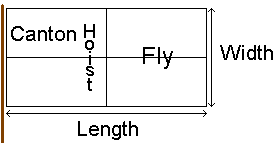Flag terminology
|
|
The design and description of flags typically uses specialised flag terminology with precise and technical meanings (a form of jargon).
Flag illustrations generally depict flags flying from the observer's point of view from left to right, the view known as the obverse; the other side is the reverse. Animals and beasts should always appear with the heads facing the flag-staff side.
Some countries use a single flag design as a national flag for all purposes. Other countries may use two or more flags for different purposes but all serving as the national flags. Vexillologists categorise such flags as:
- Missing image
FIAV_32.png
Image:FIAV_32.png
Civil Flag – Flown by citizens on land. - Missing image
FIAV_16.png
Image:FIAV_16.png
State Flag – Flown on public buildings. - Missing image
FIAV_08.png
Image:FIAV_08.png
War Flag – Flown on military buildings. - Missing image
FIAV_04.png
Image:FIAV_04.png
Civil Ensign – Flown on private vessels (fishing craft, cruise ships, yachts, etc). - Missing image
FIAV_02.png
Image:FIAV_02.png
State Ensign – Flown on unarmed government vessels. - Missing image
FIAV_01.png
Image:FIAV_01.png
War Ensign – Flown on warships.
Symbols shown are international flag identification symbols.
| Contents |
Description of standard flag parts and terms
- Badge – a coat of arms or simple heraldic symbol, such as a shield.
- Canton – any quarter of a flag, but commonly means the upper left (hoist) quarter, such as the field of stars in the flag of the United States or the Union Flag in the Australian Flag.
- Charge – a figure or symbol appearing in the field of a flag.
- Emblem – a device often used as a charge on a flag. It may be heraldic in origin or modern, for example the maple leaf on the Canadian Flag.
- Field – the background of a flag; the colour behind the charges.
- Fimbriation – a narrow edging or border, often in white or gold, on a flag to separate two other colours.
- Fly – the half or edge of a flag furthest away from the flagpole. This term also somtimes refers to the horizontal length of a flag.
- Hoist – the half or edge of a flag nearest to the flagpole. This term also sometimes refers to the vertical width of a flag.
- Length – the span of a flag along the side at right angles to the flagpole.
- Width – the span of a flag down the side parallel to the flagpole.
Basic patterns in flags
Missing image
Flag_types_gallery.png
Techniques in flag display
- Hoist – the act or function of raising a flag, as on a rope.
- Half Staff – a style of flag display in which the flag is hoisted to half of the potential height of the available flag pole. Usually this is done by first raising the flag to the top, then lowering it halfway. (Equally valid 'half-masting' is flying the flag at two-thirds of its normal height.) This usually denotes distress or a show of grief, such as mourning a death.
- Half Mast – same as Half Staff. The use of 'mast' suggests naval use, but typically the two terms are interchangeable.
- Distress – flying the flag upside-down.
External Links
- Glossary of Flag Terms at FOTW (http://www.fotw.us/flags/xf-glos.html)

